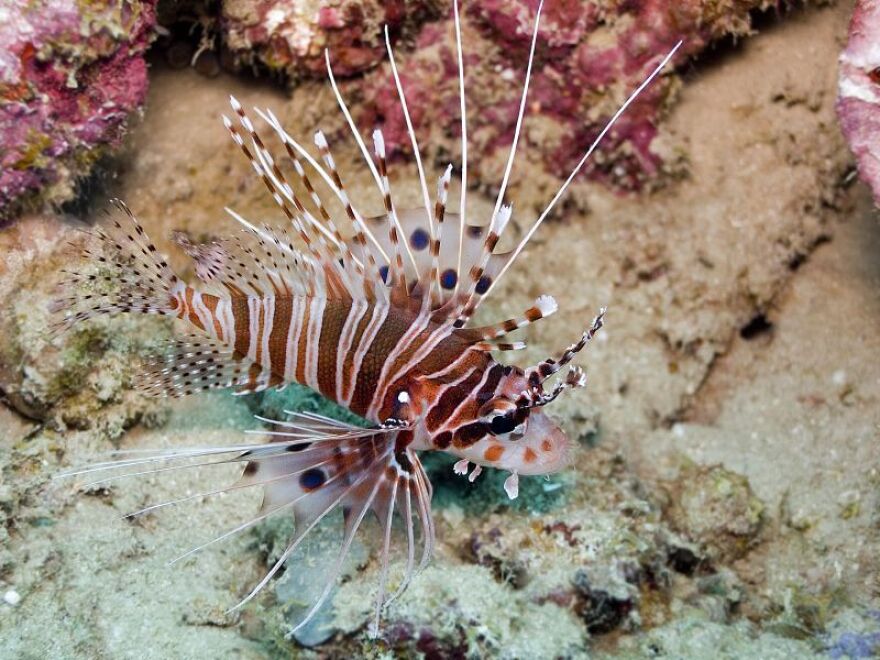Earlier this year, the Florida Fish and Wildlife Conservation Commission declared it open season on lionfish. These exotic creatures were once the darling of aquarium hobbyists. But now lionfish are taking over marine environments along Florida’s East coast and state officials want them gone.
Although slowing down the destructive non-native, invasive species is probably a more realistic goal.
A red lionfish, floating in an aquarium, is a beautiful creature. With its waving, gauzy fins and long, stiff spines, it resembles a lion - a very small lion with different colored stripes.
Max Heffler, who manages Bio Reef Saltwater Aquariums in Jacksonville, says lionfish add stripes as they grow.
“The pattern is kind of a fingerprint that grows like rings on a tree and you end up with some very large, football sized, maize-covered, black-white-red, extreme finiage, floating, venomous beasts”, said Heffler.
Floating, venomous beasts are okay in an aquarium. But, University of North Florida Coastal Fisheries Biologist Eric Johnson says that swimming free in the Atlantic Ocean, lionfish are an economic, ecological, and environmental disaster.
“Some studies in the Bahamas have shown that basically a single lionfish on a closed reef can remove 70% to 80% of the biomass within just a few weeks”, Johnson said. “It’s a perfect storm. I mean this is an animal that, it has basically all the traits that you don’t want to see in an invasive species.”
Those traits include the ability to eat fish half their size, to produce nearly 100,000 fertilized eggs a month and, Johnson says, to dazzle and confuse unsuspecting locals.
“It’s got these long thin rays and think spines that it can sort-of spread out and it uses those to herd fish into a corner or back them up against the reef”, Johnson said. “They can also squirt jets of water which can disorient and turn the prey around.”
Unfortunately, there’s nothing in the Atlantic, the Caribbean, or the Gulf of Mexico that hunts lionfish.
Amanda Nalley, with the state Fish and Wildlife Conservation Commission, said “Now there have been incidents of people saying, oh, they saw this type of fish eat a lionfish or they see a bird eat a lionfish and it does happen. But so far, we haven’t seen any significant predator that’s going after lionfish.”
Nalley says that could change, now that the state has lifted the restrictions on catching lionfish.
“Hopefully that’ll get more people in the water doing this”, Nalley said. “Hopefully that will mean more control of this invasive species.”
The question is: what do you do with a lionfish after you catch it?
“You can definitely spear the fish and leave it in the water”, Nalley said. “Some people will capture them and take them home and put them in their aquarium.”
Or you could eat them. UNF biologist Eric Johnson said, “Lionfish is actually plenty edible, despite the fact that their spines are poisonous. If handled correctly and handled well and filleted, the meat is actually pretty good.”
You can find lionfish recipes in some cookbooks and online, or you can go to The Fish House Encore Restaurant in Key Largo where co-owner CJ Berwick says lionfish are on the menu some eight months out of the year.
“We don’t serve it filleted”, Berwick said. “There is such little fillet on a lionfish. We serve ours whole.”
Minus the spines, Berwick says.
“We bread them in cracker meal and deep fry them. And then we serve them standing up. The meat is delicious, but you don’t get much of it”, said Berwick.
One of Berwick’s little lionfish appetizers will set you back around $12. In the meantime, conservationists hope more people will develop a taste for the spiny creatures.


